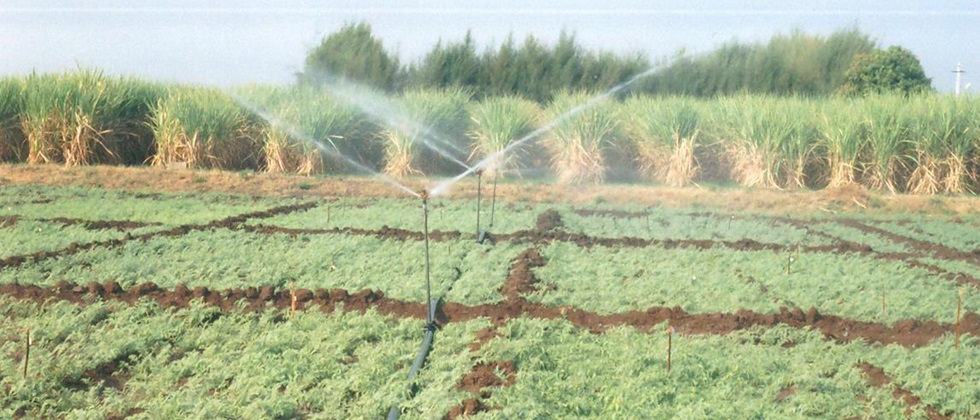
16 Points About Irrigation Management In Chickpea Crop You Should Know
- By Agrosiaa Admin --
- Mar 01, 2021--
-
Hello farmer friends!As we know Chickpea is one of the important cereal crops grown during Rabi season. This crop has a unique significance in agriculture and human diet. Friends to improve our yield proper irrigation management should follow to achieve a healthy crop and to reduce weed competition at the early crop stage.
 A HEALTHY CHICKPEA CROPSo friends, in this article we are going to learn about water requirements and their management in available water resources at different crop growth stages of Chickpea crop.
A HEALTHY CHICKPEA CROPSo friends, in this article we are going to learn about water requirements and their management in available water resources at different crop growth stages of Chickpea crop.Important points for proper irrigation management in Chickpea crop.
1. The Chickpea crop is a very water sensitive crop. The Chickpea crop requires about 25 cm of water. Give light watering after sowing. So germination was good.2. Apply in medium soil after about 25 to 30 days. Second water gives after 45 to 50 days and third water after 65-70 days if required. Watering should be done as per the soil conditions and requirements.3. Sowing is usually done on conserved soil moisture. A pre-sowing irrigation may be needed, if the available soil moisture is not adequate for germination.4. At the time of field preparation of Chickpea crop, try to keep the minimum distance between the two rows. Also the length should be kept short according to the slope of the soil, so that it is convenient to give adequate water to the crop.5. The Chickpea crop normally requires 25 cm of water. It is important to give adequate water (7 to 8 cm) every time. If too much water is given, there is a risk of crop failure due to rotting. Watering should be done as per the soil conditions and requirements.6. Kabuli Chickpea should never be irrigated immediately after sowing, particularly in deep black soils. This is because the kabuli chickpea seeds have thin seed coat and deteriorate faster as compared to desi type and are also more susceptible to seed rot and seedling damping off.7. Broad bed and furrow system or ridge and furrow system are very useful for irrigation, drainage and intercultural operations and are widely used at ICRISAT.8. Depending on the local conditions and the depth of the soil, there should be a gap between the two irrigations. Don't let the ground get too big cracks.9. Mild irrigation at the time of root rot and collor rot disease incidence under stress condition to minimize the soil temperature is helpful to manage these diseases.10. Chickpea is generally grown as a rainfed crop, but two irrigations, one each at branching and pod filling stages, are recommended for higher yield. Higher number of irrigations may lead to excessive vegetative growth in heavy soils.11. Where irrigation facilities are available, give a pre-sowing irrigation. It will ensure proper germination and smooth crop growth.12. In rainfed Chickpea if soil moisture is very low and one irrigation is possible then irrigate the crop as soon as flowering starts.13. If winter rains fail, give one irrigation at pre-flowering stage and one at pod development stage. In no case first irrigation should be given at flowering time of Chickpea crop.14. A light irrigation should be given because heavy irrigation is always harmful to Chickpea crop. Excess of irrigation enhances vegetative growth and depresses Chickpea yield.15. For remunerative cultivation of Chickpea, irrigation at branching and pod development stage with all furrows irrigated was beneficial for achieving higher production.16.Irrigation of Chickpea crop by sprinkler irrigation method and cultivation of improved varieties gives a big increase in yield. SPRINKLER IRRIGATIONIN CHICKPEA CROP
SPRINKLER IRRIGATIONIN CHICKPEA CROP
Since this crop is very sensitive to water, if more water is given than required, the crop will germinate and hence there will be a big reduction in yield. For this, sprinkler irrigation is the best method for this crop. The sprinkler system allows the crop to be irrigated as much as it needs and at the time it needs it.Conclusion
Farmer friends, here I"ll quickly summarize the conclusion as to why the irrigation management on water availability is necessary for more and quality production of Chickpea crop in this Rabi season. For this, we should take care of the following important things.- Watering should be done as per the soil conditions and requirements.
- Give light watering after sowing for good germination.
- Depending on the local conditions and the depth of the soil, there should be a gap between the two irrigation.
- In Chickpea crop flowering, pod developments are the most critical stages for irrigation.
- Use of sprinkler irrigation allows the crop to be irrigated as much as it needs and at the time it needs water.
So friends, we learned about a problem with the Chickpea crop. Now we will see in the next article how to prepare and manage the nursery for good seedlings of Tomato crop.
Stay with this friend of yours. See you soon.
Ram Ram!










IMPORTANT LINKS
http://krishi.maharashtra.gov.in/Site/Upload/Pdf/PMFBY__2020_Gr_for_publication.pdf
http://krishi.maharashtra.gov.in/Site/Upload/Pdf/PMFBY_Process_Leaflet_Final_Print_File_15-10-2020.pdf